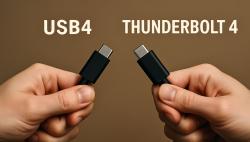Think of the breathtaking vision of the future from the movie Blade Runner – holographic ads, cyberspace, and ubiquitous networks. Can this fiction become reality? Find out what we can expect from the internet of the future and how the boundaries between reality and the virtual world will blur.

Imagine a world where reality and virtual space merge into one. A world where your thoughts travel through the internet at the speed of light and the boundaries between physical and digital are so thin you can barely distinguish them. This isn't just sci-fi fantasy – it's a future that is irreversibly approaching. What internet speeds can we expect in the coming years, and what will they enable?
From outdated dial-up to advanced fiber optics
A few decades ago, the internet was a luxury available to only a select few. Slow dial-up connections and limited data plans were soon replaced by technologies like DSL and cable connections, which brought significant acceleration.
Today, fiber optic connections are becoming the standard, allowing for dizzying speeds of several gigabits per second. This rapid development is mainly driven by increasing demand for data-intensive services, such as streaming high-resolution videos, playing graphically demanding games, and the expansion of the Internet of Things (IoT).
The future belongs to 5G and 6G networks
Imagine a world where downloading a movie takes seconds, video calls are seamless, and smart cities manage traffic with millimeter precision. This isn't sci-fi, but the future that 5G and 6G networks promise us. These technologies promise to accelerate and improve the internet to such an extent that they will change the way we live, work, and experience entertainment.
Current 4G networks, although still improving, are hitting their limits. The ever-increasing amount of data, smartphones, tablets, and other devices require more robust infrastructure. This is where 5G and 6G come into play. With download speeds of up to 10 Gbps for 5G and potentially up to 1 Tbps for 6G, the door opens to applications and services that we have only dreamed of until now.

Imagine a doctor performing surgery remotely using a robot and virtual reality, without the slightest signal delay. Or autonomous vehicles communicating in real-time, preventing accidents. These are just two examples that illustrate the transformative potential of 5G and 6G.
Both networks will not only serve faster internet browsing but will become the foundation for the development of smart cities, autonomous systems, and the Internet of Things, connecting billions of devices. With 6G, we could soon see holograms or haptic technologies, enabling us to feel remote objects by touch.
The transition to 5G and 6G, of course, comes with challenges. Building the necessary infrastructure will require significant investments. Signal coverage will expand gradually and won't be available everywhere immediately.
The internet in virtual and augmented reality: A gateway to new worlds
With the development of the internet, we are slowly but surely entering an era where connectivity is not just about download and upload speeds but about how deeply we can immerse ourselves in the digital world. Virtual and augmented reality (VR/AR) are technologies that promise to change our perspective on the internet and how we use it.
Imagine that instead of browsing traditional web pages, you find yourself inside a virtual room where you can interactively browse products in a store, meet friends in a digital square, or visit distant destinations without leaving your home.
Students will be able to attend virtual classes where they can carry out experiments in laboratories without needing physical equipment. Businesses will be able to organize meetings in virtual offices, where each participant feels like they are in the same room with the others, even though they are scattered around the world.

A quantum revolution is likely ahead
Another technological revolution looms on the horizon that could push the internet into realms unimaginable today – quantum computers. These machines with unprecedented computing power, based on the principles of quantum mechanics, could transform the very fabric of the internet.
Imagine a network that is not only exponentially faster than anything we know today but also unbreakably secure thanks to quantum encryption. Such a network would withstand any hacking attempt and guarantee absolute data protection.

Quantum computers could also speed up and streamline countless online processes, from searching for information and simulating complex systems to developing new materials and drugs. But that's not all. Quantum computers could enable entirely new forms of online services and applications that we can't even imagine today.
Fast and accessible internet is crucial not only for entertainment but also for economic growth, innovation development, and improving the quality of life. It enables the creation of new industries, simplifies remote work, and makes education and information accessible to all without distinction.
Investments in technology and infrastructure open the door to a future where the online world will be accessible to everyone without limitations, and connectivity will drive progress.
USB4 vs Thunderbolt 4: How Do They Differ and Which is Better?

Want faster connections and fewer cables? USB4 and Thunderbolt 4 are the future. Our article clearly presents what these technologies can do, how they differ, and which is best for you. Whether you're a gamer or a content creator, USB4 and Thunderbolt 4 make life a lot easier.
What are botnets and how can they turn your computer into a hacking weapon?

Botnets represent one of the most dangerous weapons of cybercriminals. These are networks of infected computers that are secretly controlled remotely. Your computer can become part of this army of "zombie" devices and be misused for DDoS attacks, spam distribution, cryptocurrency mining, or data theft. How to recognize that you are a victim and how to effectively protect yourself?
Optimizing the internet for a smart home: How to set up a network for IoT devices?

Looking for a way to ensure your smart home operates without interruptions and issues? Proper setup of a home network is crucial for the smooth operation of all connected devices. Our article will guide you through selecting the right router, its strategic placement, and optimal settings for different types of households.
5 alternatives to ChatGPT: Choose Your AI Assistant Tailor-Made

ChatGPT has changed the world of artificial intelligence, but it's not the only player in the AI assistant field. Discover five intriguing alternatives with different focuses – from analytical Claude to the versatile Gemini and the European Mistral. Each excels in different areas and offers you distinct functionalities.
AI in 2025: Everything You Need to Know About Artificial Intelligence

We will guide you through the basic concepts of AI, from machine learning to neural networks and natural language processing. You'll learn how to start practicing AI, which tools to use, and how to keep up with this fast-evolving field.
Ping vs FPS: What Slows You Down in Games and How to Fix It?

Ping and FPS are two key elements that determine the quality of your gaming experience. While ping reflects the speed of communication between your device and the game server, FPS determines the smoothness of the game's graphics. In our guide, you'll learn how to identify errors and how to easily fix them.